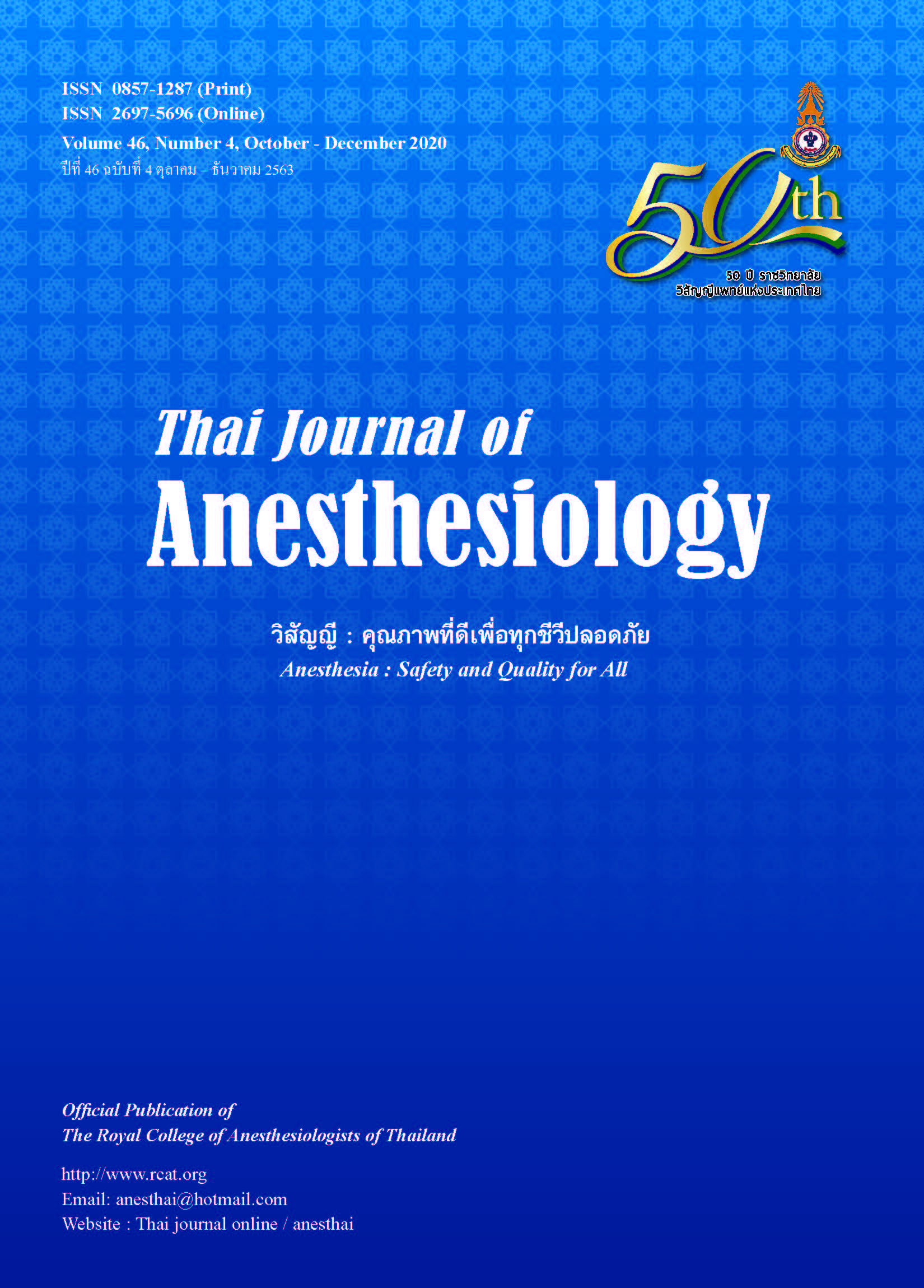Associated Factors of Perioperative Shivering in Patients Undergoing Orthopedic Surgery under Spinal Anesthesia
Main Article Content
Abstract
Background: Perioperative shivering is common adverse event, causes many serious complications such as hypoxemia, myocardial ischemia, cardiac arrhythmia. Objectives: To identify associated and risk factors of perioperative shivering in patients undergoing orthopedic surgery under spinal anesthesia. Methods: This was a retrospective case-control study. The orthopedic patients aged 15-85 years undergoing spinal anesthesia at Maharat Nakhon Ratchasima Hospital during April 2019 and September 2019 were reviewed. Fifty eight shivering patients were identified and labeled as a case group. One hundred sixteen patients were enrolled as a control group. The associated factors were extracted: gender, ASA, age, weight, height, BMI, Hct, type and milligrams of bupivacaine, total intravenous fluid administration, total blood loss, total blood replacement, anesthetic and operative time, operative site and anesthetic level. All associated factors were analysed by univariate and multivariate analysis for crude and adjusted odds ratios. Results: The shivering group had lower weight, lower height and lower BMI. The milligrams of bupivacaine, total blood loss and operative site at hip and femur were higher in the shivering group. From univariate analysis, crude odds ratios of weight<60 kg, bupivacaine >15 mg, operative site at hip and femur were 2.598, 2.224 and 2.591, respectively. From multivariate analysis, only weight<60 kg was in the equation with adjusted odds ratio 2.429. Conclusion: The risk factor from multivariate analysis was weight less than 60 kg.
Article Details
References
PO2
during recovery from anaesthesia. Br J Anaesth 1968;
40:398-407.
2. Frank SM, Fleisher LA, Oslon KF, et al. Consequences of
hypothermia. Curr Anaesth Crit care 2001;12:79-86.
3. Leopold H, J Eberhart, Friederike D, et al. Independent risk
factors for postoperative shivering. Anesth Analg 2005;101:
1849-57.
4. Crossley AW. Six months of shivering in a district general
hospital. Anaesthesia 1992;47:845-8.
5. Kim YS, Kim YI, Seo KH, et al. Optimal dose of prophylactic
dexmedetomidine for preventing postoperative shivering. Int
J Med Sci 2013;10:1327-32.
6. Blaudszum G, Lysakowski C, Elia N, Tramer M. Effect of
perioperative systemic alpha2 agonists on postoperative
morphine consumption and pain intensity: systemic
review and meta-analysis of randomized controlled trials.
Anesthesiology 2012;116:1312-22.
7. Kurz A, Sessler DI, Narzt E, et al. Postoperative hemodynamic
and thermoregulatory consequences of intraoperative core
hypothermia. J Clin Anesth 1995;7:359-66.
8. Jones HD, McLaren CAB, Postoperative shivering and
hypoxaemia after halothane, nitrous oxide and oxygen
anaesthesia. Br J Anaesth 1965;37:35-41.
9. Ciofolo MJ, Clergue F, Devilliers C, Ben Ammar M, Viars P.
Change in ventilation, oxygen uptake and carbon dioxide
output during recovery from isoflurane anesthesia.
Anesthesiology 1989;70:737-41.
10. Frank SM, Beattie C, Christopherson R, et al. Unintentional
hypothermia is associated with postoperative myocardial
ischemia. The perioperative ischemia randomized anesthesia
trail study group. Anesthesiology 1993;78:468-76.
11. Kiekkas P, Poulopoulou M, Papuhatzi A, Souleles P. Effects
of hypothermia and shivering on standard PACU monitoring
of patients. AANA J 2005;73:47-53.
12. DE Courcy JG, Eldred C. Artefactual hypotension from
shivering. Anaesthesia 1989;44:787-8.
13. Buggy DJ, Crossley AWA. Thermoregulation, mild
perioperative hypothermia and post-anaesthetic shivering.
Br J Anaesth 2000;84:615-28.
14. Feldmann ME. Inadvertent hypothermia: a treat to
homeostasis in the postanesthetic patient. J Post Anesth
Nurs 1988;3:82-7.
15. Sessler DI, Rubinstein EH, Moayeri A. Physiologic responses
to mild perianesthetic hypothermia in humans. Anesthesiology
1988;68:843-50.
16. Horn EP, Schroeder F, Wilhelm S. Postoperative pain
facilitates nonthermoregulatory tremor. Anesthesiology 1999;
91:979-84.
17. Fiedler MA, Thermoregulation: anesthetic and perioperative
concerns. J Am Assoc Nurse Anesth 2001;69:485-91.
18. Horn EP, Sessler DI, Standl T. Non-thermoregulatory
shivering in patients recovering from isoflurane or desflurane
anesthesia. Anesthesiology 1998;89:878-86.
19. Cohen M. An investigation into shivering following
anaesthesia-a preliminary report. Proc Roy Soc Med 1967;
60:752-3.
20. Siew-Fong NG, Cheng-Sim OO, Khiam-Hong L, et al. A
comparative study of three warming interventions to
determine the most effective in maintaining perioperative
normothermia. Anesth Analg 2003;96:171-6.
21. Panagiotis K, Maria P, Argiri P, et al. Effects of hypothermia
and shivering on standard PACU monitoring of patients.
AANA J 2005;73:47-53.
22. Bayter-Marin JE, Rubio J, Valedon A, Macias AA.
Hypothermia in elective surgery: The hidden enemy. Rev
Colomb Anesthesiol 2017;45:45-53.


